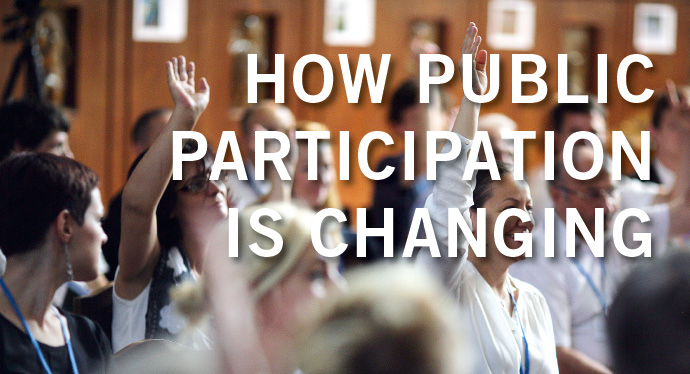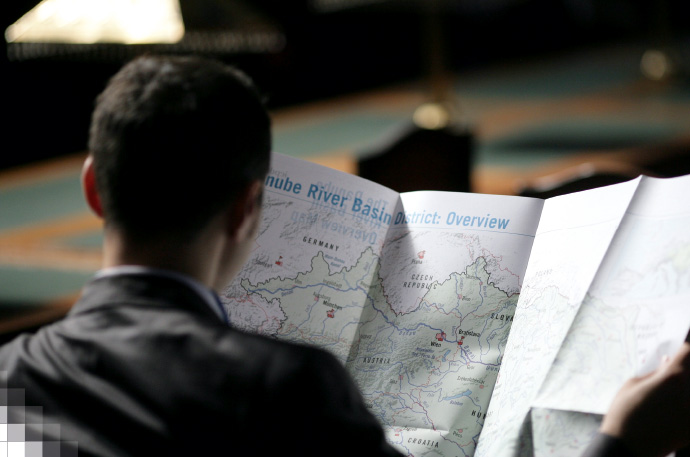Danube Watch 3/2018 - HOW PUBLIC PARTICIPATION IS CHANGING

Until recent years, the options available to the public when it came to participating in the management of their own waters was limited at best. National and local governments would often authorise water development plans, infrastructure projects, and the privatisation of water services without consulting the local community. This sometimes undermined livelihoods in local communities and led to both individuals and organisations increasingly demanding greater consultation with more transparent and accountable decision-making. The times, however, are changing.
Increasing environmental awareness, a greater understanding of how it affects human health, plus the more direct contact of social media all mean that public participation in these processes is very much on the rise. The public now, and rightfully so, very much expect the opportunity to participate easily in the policy-making processes that concern their environment. This is a vital shift, considering that environmental policy and management only succeed if key stakeholders feel engaged, and buy into the design of all the actions concerned.
Today, a ‘bottom-up’ approach means that people can share information and responsibilities; they can partake in the design of programmes; monitor and evaluate progress; and all without central management. Key forms of participation, such as the dissemination of information, public advocacy, public hearings and litigation, assist environmental decision-makers in identifying the concerns of the general public. A recent shift towards decentralising strategies also encourages the active participation of organised groups, communities, and citizens at a more local level.
UPDATING OUR PARTICIPATION PRACTICES
So what does this mean for the ICPDR? One of our most important commitments is to encourage public participation in all our activities and decision-making wherever possible - so it most definitely means good things for us! The increasing number of ways in which the public can be reached is useful for broadening our methods and putting together a new plan for engaging the public, exploiting rising awareness in order to facilitate broader support for our policies and greater efficiency in their effective implementation.
 The ICPDR is committed to active public participation in its decision making. The commission believes that this facilitates broader support for policies and leads to increased efficiency in the implementation of actions and programmes. Active consultation with stakeholders takes place throughout the entire cycle of all ICPDR activities, ranging from developing policies, to implementing measures and evaluating impacts. A legal framework for this is provided by Article 14 of the EU Water Framework Directive along with Articles 9 and 10 of the EU Floods Directive.
The ICPDR is committed to active public participation in its decision making. The commission believes that this facilitates broader support for policies and leads to increased efficiency in the implementation of actions and programmes. Active consultation with stakeholders takes place throughout the entire cycle of all ICPDR activities, ranging from developing policies, to implementing measures and evaluating impacts. A legal framework for this is provided by Article 14 of the EU Water Framework Directive along with Articles 9 and 10 of the EU Floods Directive.
Working to a six-year working cycle, we updated our plans for the Danube River Basin Management Plan (DRBM) and Danube Flood Risk Management Plan (DFRM) in 2015. The update was accompanied by new requirements for public consultation. Carried out in three main phases, we collected comments from the public during the update, asking them about the timetable and work programme, as well as water and flood management issues. These public consultations each spanned periods of at least six months, utilising the ICPDR network to gather and disseminate information. The resulting timetable and work programme was then published and made publicly accessible. Six years hence, it is now time to replicate this exercise.
Our planned update to proceedings in 2021 will follow on with this emboldened programme of public consultation, along with information and educational initiatives aimed at keeping our stakeholders and the public well-informed. These include the Danube Day - celebrating everything about the river anually on 29th June - the publication of our in-house magazine, Danube Watch, three times a year and consultation workshops such as Voice of the Danube.
INFORMING THE PUBLIC
Communities can become more meaningfully involved in the work of the ICPDR if they are well informed about its objectives and structure. Public information, educational initiatives and outreach activities are therefore already being utilised to support public participation, in addition to the more general use of social media as a communication tool. The ICPDR is currently engaged in the following public participation activities:
- public information dissemination. This includes social media posts, technical reports, public documents and general publications (e.g. Danube Watch);
- awareness-raising educational resources, including environmental education. This includes a variety of proposed new materials, awareness raising activities (e.g. the annual Danube Day festivities) and outreach;
- public consultation activities. These can be events such as Q&A sessions regarding the development of river basin management plans, and the opening of subject-related communication channels or consultation workshops. The use of ICPDR.org for publishing information about these issues is essential.
Acting early is also important. By ensuring buy-in and a sense of ownership in our target audience at an early stage of the process, any basin/sub-basin approach will stand a better chance of success. The benefits of early engagement in the development and design of our two plans and projects include:
- fewer misunderstandings, fewer delays and more effective implementation and monitoring;
- the resulting smoother running of a project can lead to more cost-effective solutions;
- all later decisions are more likely to receive public acceptance, commitment and support. Attitudes to the decision-making process will also be generally improved;
- increasing stakeholder awareness of the various issues in the related river basin district and sub-basins before environmental efforts become worse and thus harder to resolve;
- helping to normalise common discourse earlier in the implementation process.
GETTING INFORMED BY THE PUBLIC
Just as important as us communicating with the public, is the public communicating with us. A key part of the ICPDR’s comunication strategies is always direct consultation and enabling the public to send us all of their comments and raise all of their concerns regarding Danube River Basin management issues. This could be suggestions for new wording, raising questions, providing fresh scientific information - everything is of value. Major activities tend to happen at six-monthly intervals. For example, we are currently collecting comments on our draft timetable, work programme, and the statement of our consultation measures. All comments will be included in a revised version to be published in the autumn of 2019.






